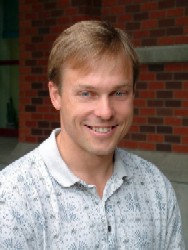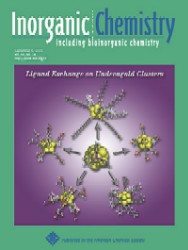Home > Press > Libraries of gold nanoparticles
Abstract:
University of Oregon work appears on cover of Inorganic Chemistry
Chemists perfect fast way to synthesize libraries of gold nanoparticles
September 06, 2005
Not all libraries contain books. In chemistry, the word library is used to refer to a collection of molecules. University of Oregon chemist Jim Hutchison's new way of rapidly generating libraries of tiny particles with great promise for research and development at the nanoscale is featured on the cover of the Sept. 5 issue of Inorganic Chemistry.

Jim Hutchison, University of Oregon. Copyright © & Photo credit: Jack Liu
|
"We've discovered a method for generating a diverse library of functionalized gold particles quickly and easily," said Hutchison, who directs the university's Materials Science Institute. "Basic research of this type is the key to finding out what kinds of new electronic, optical and pharmaceutical products actually will come to market."
The article describes how to synthesize the versatile particles, built with cores of 11 gold atoms, and discloses their properties. Nanomaterials and technologies are projected to become a trillion dollar industry by 2010 and affect every industrial and consumer product sector, Hutchison said.
One of the keys to understanding the size-dependent properties and applications of nanoparticles is generating libraries of particles with different sizes for physical study. Earlier this year, Hutchison's laboratory reported success in generating a similar library of larger particles, with cores having about 100 gold atoms, in the Journal of the American Chemical Society. The 11-atom and 100-atom libraries span a size range of 0.8 to 1.5 nanometers, a range of particular interest to nanoscientists and technologists.
Hutchison co-authored the Inorganic Chemistry article with Gerd Woehrle, one of his doctoral students. Woehrle is now finishing post-doctoral work at the Max Planck Institute in Germany.
Already known as world leaders for encouraging the teaching of green chemistry principles, Hutchison and his Oregon colleagues are pioneering the field of green nanoscience. His role in laying out the conceptual template for how to design "green" or environmentally-benign nanosubstances was described in the March issue of Environmental Science & Technology.
Hutchison is a member of ONAMI, the Oregon Nanoscience and Microtechnologies Institute. The National Science Foundation, the Alfred P. Sloan Foundation and the Camille and Henry Dreyfus Foundation, Inc., have funded his research.
Melody Ward Leslie
mleslie@uoregon.edu
541-346-2060
Copyright © University of Oregon
If you have a comment, please Contact us.
Issuers of news releases, not 7th Wave, Inc. or Nanotechnology Now, are solely responsible for the accuracy of the content.
| Related News Press |
Materials/Metamaterials/Magnetoresistance
![]() First real-time observation of two-dimensional melting process: Researchers at Mainz University unveil new insights into magnetic vortex structures August 8th, 2025
First real-time observation of two-dimensional melting process: Researchers at Mainz University unveil new insights into magnetic vortex structures August 8th, 2025
![]() Researchers unveil a groundbreaking clay-based solution to capture carbon dioxide and combat climate change June 6th, 2025
Researchers unveil a groundbreaking clay-based solution to capture carbon dioxide and combat climate change June 6th, 2025
![]() A 1960s idea inspires NBI researchers to study hitherto inaccessible quantum states June 6th, 2025
A 1960s idea inspires NBI researchers to study hitherto inaccessible quantum states June 6th, 2025
![]() Institute for Nanoscience hosts annual proposal planning meeting May 16th, 2025
Institute for Nanoscience hosts annual proposal planning meeting May 16th, 2025
Announcements
![]() Rice membrane extracts lithium from brines with greater speed, less waste October 3rd, 2025
Rice membrane extracts lithium from brines with greater speed, less waste October 3rd, 2025
![]() Researchers develop molecular qubits that communicate at telecom frequencies October 3rd, 2025
Researchers develop molecular qubits that communicate at telecom frequencies October 3rd, 2025
![]() Next-generation quantum communication October 3rd, 2025
Next-generation quantum communication October 3rd, 2025
![]() "Nanoreactor" cage uses visible light for catalytic and ultra-selective cross-cycloadditions October 3rd, 2025
"Nanoreactor" cage uses visible light for catalytic and ultra-selective cross-cycloadditions October 3rd, 2025
|
|
||
|
|
||
| The latest news from around the world, FREE | ||
|
|
||
|
|
||
| Premium Products | ||
|
|
||
|
Only the news you want to read!
Learn More |
||
|
|
||
|
Full-service, expert consulting
Learn More |
||
|
|
||









